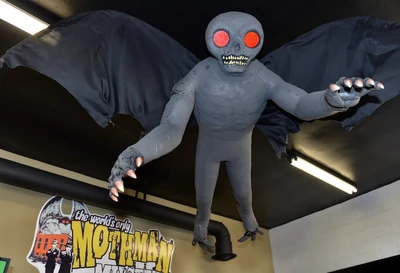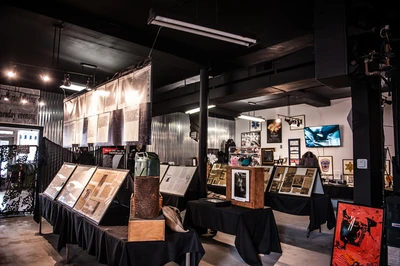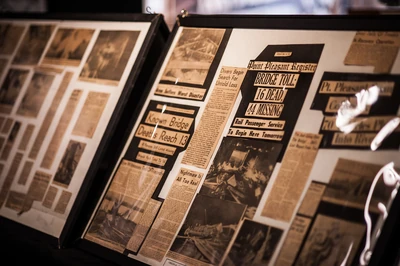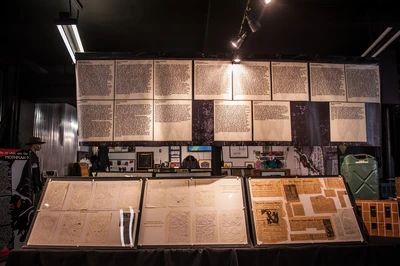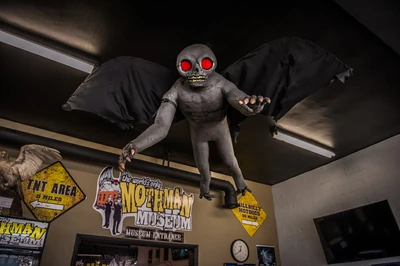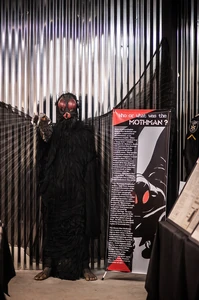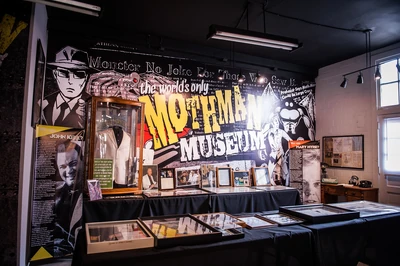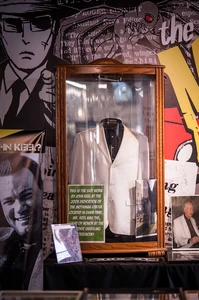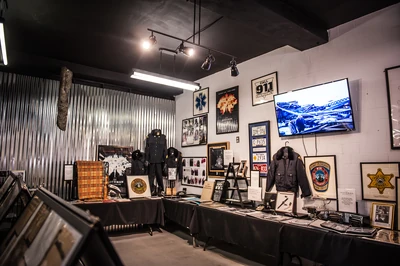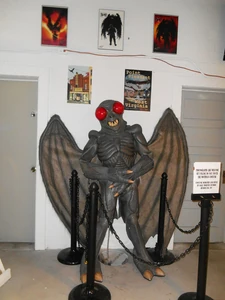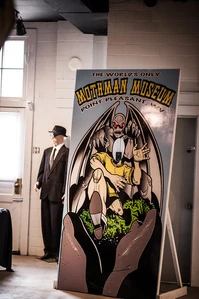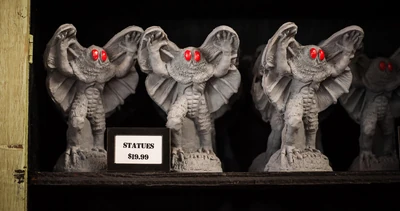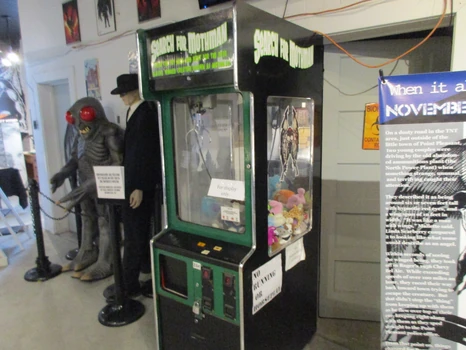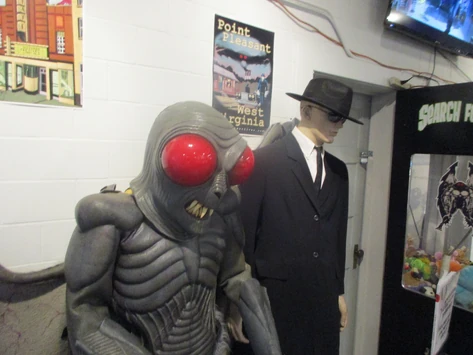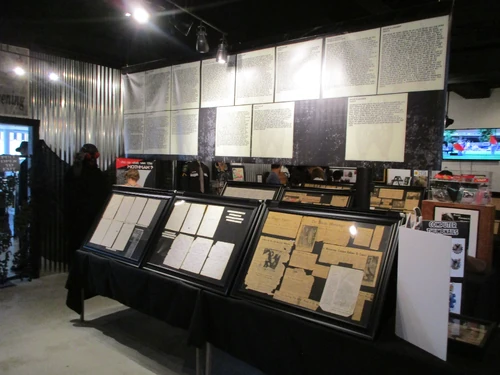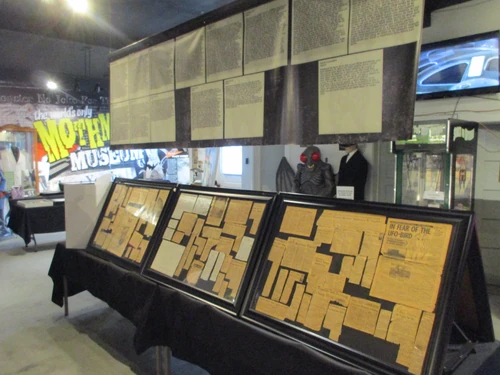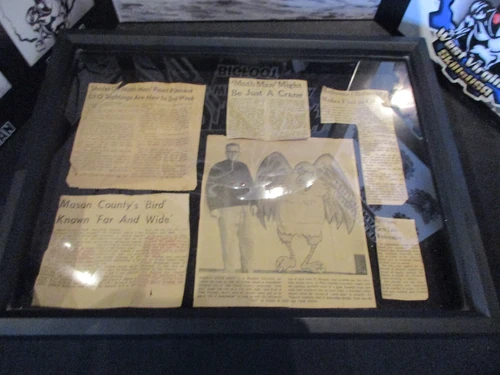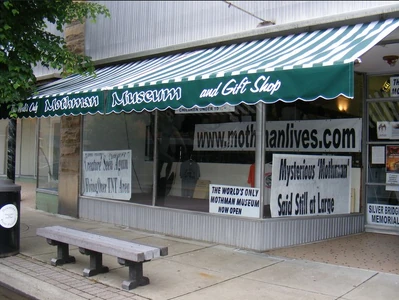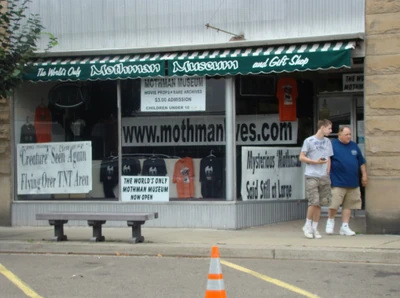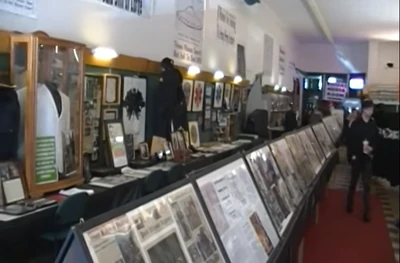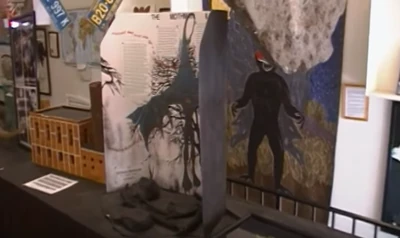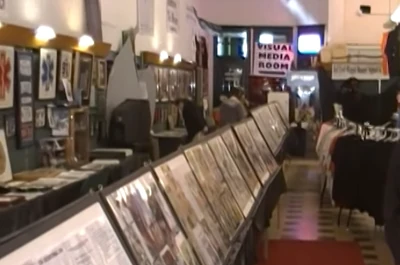About
The Mothman Museum was opened in 2005 by Jeff Wamsley. It is a museum dedicated to the Mothman of West Virginia folklore.
The museum is located right next to The Mothman statue on Main Street in Point Pleasant, The town in which the original 1966 -1967 Mothman sightings are said to have occurred.
Its the World's Only Mothman Museum and Shop, The #1 destination for Mothman fans and for things to do in Point Pleasant.
The Mothman Museum is the only place where you can see the largest collection of props and memorabilia from the movie "The Mothman Prophecies" and read rare historical documents from the Scarberry and Mallette Mothman eyewitnesses documenting what they experienced that fateful night on November 15th 1966.
The museum contains rare press clippings and photographs of the Silver Bridge disaster and information about the historical figureheads of the Mothman legacy like John Keel, Mary Hyre, and the many eyewitnesses. The museum is open seven days a week from 12pm to 5pm, excluding major holidays. It is the premiere stop for Mothman fans and entry is $3.00 for adults and $1.00 for kids ages 10 and under.
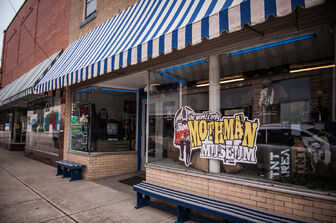
The Mothman Museum Contains:
- Rare archives all about Mothman and the mysterious happenings that occurred in Point Pleasant in 1966 and 1967.
- Rare handwritten police reports from the original Mothman eyewitnesses documenting what they experienced.
- Original press clippings, video footage of the Silver Bridge disaster and Mothman articles.
- Exhibits on John Keel, Mary Hyre and The Silver Bridge.
- Lifelike costume/replica (perfect for photo opps).
- "Search for the Mothman" Documentary
- Mothman Prophecies movie prop collection used in the film.
- The Merchandise Store filled with Mothman souvenirs (T-shirts, hoodies, novelties, carrying bags, books, Mothman Energy drink, stickers, buttons, and more). Basically everything Mothman!
- Located right next to the famous Mothman Statue
The Exhibits:
The TNT Area Exhibit
The first exhibit is about what locals refer to as The TNT Area or the McClintic Wildlife Management Area. This exhibit displays actual artifacts from the West Virginia Ordance works facility that took place in The TNT Area during World War II.
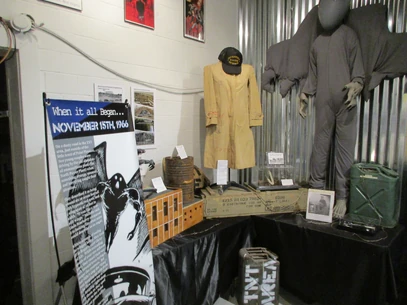
Many of the Mothman sightings are said to have taken place in or around The TNT Area leading people to think of it as Mothman's home or hideout.
On display in the museum is a miniature replica of the North Power Plant. The abandoned North Power Plant building was the location of several Mothman reports including the initial Scarberry and Mallette sighting which was the first to make local news in November of 1966.
The teens speculated that the creature, which locals then referred to as simply "The bird", lived in the North Power Plant. The building eventually came to be known as "The Bird House". Throughout 1966 and 1967 many West Virginia locals and sightseers flocked to the area in search of the monster. Volunteer police officers and firemen estimated that each car in the area had at least one gun.
In the exhibit is a miniature replica of Roger Scarberry's Black 1957 Chevy which the four teens were in during the encounter. There's also TNT area fuel tank, powder container and railroad stakes. Standing above it all is a gray Mothman figure.
A long poster beside the table features a Mothman illustration by Gary Gibeaut and details the Scarberry and Mallette sighting. It reads the following:
When it all began... November 15th, 1966 On a dusty road in the TNT area, just outside of the little town of Point Pleasant, two young couples were driving by the old abandoned ammunitions plant (the North Power Plant) when something strange, unusual and terrifying caught their attention. They described it as being around six or seven feet tall with hypnotic red eyes, and a wing span of 10 feet in width, "It was like a man with wings." Mallette said. Linda Scarberry compared it to looking like what some would describe as an angel. Within seconds of seeing the winged being, they took off in Roger's 195[7] Chevy Bel Air, While exceeding speeds of over 100 miles an hour, they raced their way back toward town trying to escape the creature. But that didn't stop the "thing" from keeping up with them as he flew over top of their car, keeping right along with them as they sped straight to the Point Pleasant police office. From that point on, things changed for Roger and Linda Scarberry and their friends, Steve and Mary Mallette, all because of the events of that fateful night on November 15th, 1966. They were never the same and some believe that night was the pinnacle event that resulted in more strange things to come for the small town of Point Pleasant...and it was.
The Mothman Claw Machine
The Museum features a black and green Mothman themed claw machine on display. The sides have Mothman illustrations on the glass and the top banner reads "Search For Mothman - Roam The TNT Area and hunt for the ever elusive winged creature known as Mothman".
Dale Morton's Mothman Costume
Next is the Mothman costume created by Dale Morton. This costume stands as a photo opportunity in the Mothman Museum but is also used during the Mothman festival.
Billboard Cut-Out Art
This art piece is a Mothman billboard with a cut-out for people to place their face into. Steps are located on the back. It reads "World's only Mothman Museum - Point Pleasant, West Virginia" and features art of Mothman chasing someone away, illustrated by Larry Blake.
Newspapers and Press Clippings
A large portion of the Museum is display frames preserving Mothman related press clippings from the 60's. These important news articles document the strange sightings and offer a glimpse back into the time in which these things were being reported. They give proper historical context to the legend and insight into the forming of the folklore. They remind us of the Mothman's roots as a social and cultural phenomenon.
These newspapers were provided to the Museum by Linda Scarberry, the display frames also house police reports written by her which detail her experiences.
The John Keel Exhibit
This exhibit is dedicated to John Keel, author of The Mothman Prophecies. The front table features a box of some John Keel books, including Our Haunted Planet and various editions of The Mothman Prophecies. There's John Keel magazine articles, Mothman related comic books, A Point Pleasant themed monopoly game, A Fate Magazine article about The Mothman Festival and letters from John Keel to Point Pleasant residents and witnesses. Some of these letters are addressed to Mabel McDaniel who is the mother of Linda Scarberry and also claimed to have encountered the Mothman herself.
This table of information also includes an old history textbook from Point Pleasant High School, where many of the Mothman witnesses went, including the Scarberry and Mallettes. The interesting thing about this textbook is that on Chapter 1 there is a sketch of the infamous Mothman supposedly drawn by Steve Mallette whom previously owned the book. George Dubbing later acquired the book provided it to the museum. He was a 16-year-old sophomore at the time of the Mothman reports.
The back table has frames of various John Keel and Mothman related documents including the original rough draft pages of The Mothman Prophecies, Keel autographs and photos, more Keel related articles, letters and newsprint, Mothman coloring books, comics and even a letter to John Keel from United States Senator Robert F. Kennedy.
The exhibit also contains the old Point Pleasant 30th Street sign. In the late 1960's during the Mothman reports, John Keel would often stay on this street at the homes of the eyewitnesses. It's also the street in which Museum curator Jeff Wamsley grew up.
The main focal point of the John Keel exhibit is a glass display case containing a white suit which John Keel wore to the 2nd Annual Mothman Festival in 2003. It was John Keel's last trip to Point Pleasant. He was the festival's guest of honor and was present during the unveiling of the Mothman statue. Surrounding the encased suit are photos of Keel wearing it during that festival. The Men In Black had met their mirror image with John Keel, a man in white.
The long poster reads as following:
Who was John Keel ? In 1966 John Keel became hooked on the subject of UFOs. He traveled all over the country interviewing witnesses and conducting his own field research on the subject. But the paranormal activity that was overtaking the small town throughout 1966-1967 resulting in Keel adopting that area as his own research microcosm. He had already received numerous reports of strange phenomena that people were experiencing in what he labeled as a UFO flap. As it turned out, Keel would not be disappointed with his selection of Point Pleasant. Upon arriving in Point Pleasant, Keel soon finds the impossible coincidences and strange phenomena would follow him wherever he traveled. He would find the same thing to be happening with any of the eyewitnesses of the creature that was later dubbed "the Mothman." Keel stayed in contact with some of the eyewitnesses for many years and would frequently travel back to Point Pleasant from his home in NYC to conduct more investigations. Keel himself never had a run in with the infamous Mothman, but he often would see strange lights over the town of Point Pleasant in which he claimed were real life UFOs. Eight years later he published "The Mothman Prophecies" which was based on the events he experienced during his time in the small town. More than twenty years after that, a major motion picture was released based on his book.
The Mary Hyre Exhibit
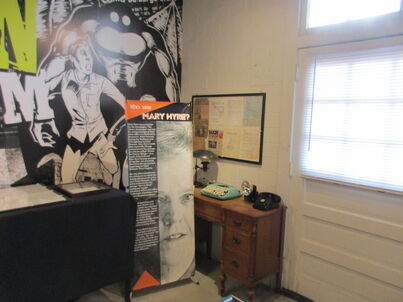
This exhibit features information about local reporter Mary Hyre who wrote about the odd happenings in Point Pleasant. The Museum doesn't have any of Mary Hyre's belongings so instead an old wooden desk, typewriter, phone, lamp and camera stand in place to convey to the visitor what it would be like to be a small town reporter in the late 1960's.
Mary was determined to figure out what was going on. She worked with John Keel, helping with his investigations and keeping him updated through correspondence. She claimed to have seen the weird lights in the sky on several occasions and even claimed to have been visited by mysterious Men In Black. The Mothman Prophecies by John Keel is dedicated "To Mary Hyre and the people of West Virginia".
The long poster reads as following:
Who was Mary Hyre? Mary Hyre was a reporter for the newspaper, "The Athens Messenger" and was the acting manager at their sister office on 6th Street in downtown Point Pleasant. During the Mothman and UFO sightings in Point Pleasant, Mary Hyre would often report the strange occurrences in her newspaper column called "Where the Waters Mingle." As a result, John Keel and Mary Hyre became associated together out of mutual interest in the paranormal happenings in Point Pleasant, West Virginia. She was often relentless in her endeavors to report the strange phenomenon going on in Point Pleasant. Some believed this led to the strange "Men In Black" paying her regular scheduled visits to her office in attempts of putting a stop to her released newspaper reports. Her most notorious and well known stories were ones in which she regretted ever having to write, these were the numerous reports that she released on the collapse of the Point Pleasant Silver Bridge which killed 46 people on a late December evening of 1967. Mary Hyre died at 54 years of age and had worked for "The Athens Messenger" for 27 years. She was dedicated to her family, her career, her hometown, and to her interest of paranormal occurrences happening in Point Pleasant.
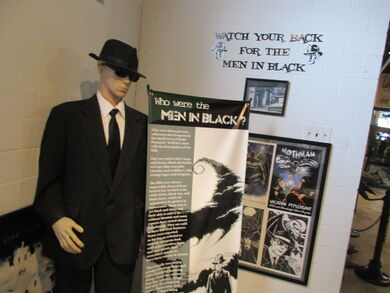
The Men In Black Exhibit
The Men In Black of West Virginia folklore are featured in the Museum through dark suited mannequins as well as wall stickers depicting a classic John Keel phrase "Watch your back for the Men In Black". The MIB were supposedly part of the strange occurrences going on in Point Pleasant in '66 and '67 with several sightings reported of strange men in black suits attempting to silence people.
The long poster features a MIB illustration by Gary Gibeaut and reads as following:
Who were the Men In Black ? Who were these persons unknown that frequented the small town of Point Pleasant? Well let's start with the description of the MIB. They are said to drive large and always black old-fashioned cars that resemble Lincolns and Cadillac's with strange logos and insignias. The MIB were always impeccably dressed from head to toe, in black suits, white shirts, black ties, and black shoes which all appeared to be perfect in appearance. Their hair is jet black and shiny and their skin is said to be without blemish and some reports and have stated almost translucent. They are said to have had dark features. Some were reported as having an oriental or eastern European look with expressionless faces and movements that sometimes appear to have been robotic in nature. They usually traveled in groups of two or three and had a knack for knowing things about the witnesses that they taunted, things that only the witnesses knew, there were even reports of them being masters of illusion by way of being able to make themselves appear and disappear without trace. Some thought they were aliens. Some thoughts they were government agents. Some thought they were from a spiritual realm. Whoever they were, they left a strong impression on those who witnessed these mysterious men when they roamed the streets of Point Pleasant.
The Silver Bridge Exhibit
This exhibit is about The Point Pleasant Silver Bridge which collapsed on December 15th 1967. The exhibit features information and news clippings about the historical tragic event as well as structural information and even a piece of the bridge itself.
The long poster reads as following:
The Old Silver Bridge The general Corportation and the American Bridge Company constructed the Silver Bridge in 1928. It was designed as a two-lane eye-bar suspension bridge, measuring 2,235 feet in total length. The bridge was designed under the specifications set forth by the American Society of Civil Engineers. The design criteria required was an H-15 load demand. The load demand is the weight restrictions and guidelines that the designing engineers must factor into their design considerations. The bridge was dubbed the "Silver Bridge" because it was the country's first aluminum painted bridge. Some unique engineering techniques were featured on the Silver Bridge such as "High Tension" eye-bar chains, a unique anchorage system, and "Rocker" towers. The Silver Bridge was the first eye-bar suspension bridge of its type to be constructed in the United States. On December 15, 1967 at approximately 5 p.m., the U.S. Highway 35 bridge connecting Point Pleasant, West Virginia and Kanauga, Ohio suddenly collapsed into the Ohio River, At the time of failure, thirty-seven vehicles were crossing the bridge span, and thrirty-one of those automobiles fell with the bridge. Forty-six individuals perished with the buckling of the bridge and nine were seriously injured. Ironically, the Silver Bridge collapsed exactly thirteen months from the day of the original sighting of Mothman In Point Pleasant, which was on November 15th 1966, and it was the 13th eye-bar that resulted in the bridge's collapse.
The Mothman Movie Exhibit
In 2002 a movie was released loosely based on The Mothman Prophecies by John Keel.
When filming wrapped on The Mothman Prophecies movie, the producers auctioned off the film's props for charity. Butch Kane, of Kittanning Pennsylvania, purchased as many movie props and pieces that he could afford.
Once his collection was complete, he displayed it in his grocery store and later brought the prop collection to the town's Mothman Festival in 2002, 2003 and 2004.
In late 2005, after interest in the movie died down in Kittanning PA, Butch graciously donated his entire collection of Mothman movie props to the Mothman Museum where it was put on display for all to see.
The props include news and magazine articles about the movie, posters and photos autographed by the actors, police uniforms used in the movie, items used in the diner scene, the broken window from the car crash scene, Point Pleasant logos and license plates from the movie, prop debris from the bridge scene, Mothman drawings from the hospital scene, a blanket from the hotel scenes and even the Chapstick prop.
There's also the black Western Electric twelve button touch-tone desk phone with gray face-plate and added red light which was used during the dramatic telephone sequences of the movie. Although the film greatly differs from the source material, it certain increased interest in the Mothman legend.
The long poster reads as following:
The Movie Versus Reality The Mothman Prophecies differed in reality when compared side by side to the real Mothman legend. The actual events that took place here in Point Pleasant, happened in 1966 and not in current, modern day times. In the movie, 36 people died during the silver bridge collapse, when in reality, it was 46 people who perished when the bridge fell on December 15th, 1967. The Movie also said that the cause of the collapse was never explained, but it was later proven that a crack in the 13th eye-bar was the reason for the collapse. On numerous occasions, John Keel received several strange phone calls with odd sounds and warnings about impending disasters. The movie portrayed Richard Gere's character in the same way, although John Keel did not have an interaction with Indrid Cold. The dreams about Christmas presents floating in a body of water did actually happen. It was local reporter and close friend of John Keel (Mary Hyre) who had these strange apparitions. When the bridge collapsed, it was during rush hour traffic two weeks before Christmas, at peek holiday shopping time. Interesting Fact: It was John Keel who wrote the book "The Mothman Prophecies." In the movie, Alexander Leek is Keel spelled backwards. Interesting Fact: The movie was filmed in Kittanning, Pa. No scenes were ever filmed in Point Pleasant. Intresting Fact: The Point Pleasant police and fire department vehicles and personnel were actively used as extras and props in the movie.
The Carolin Harris Exhibit
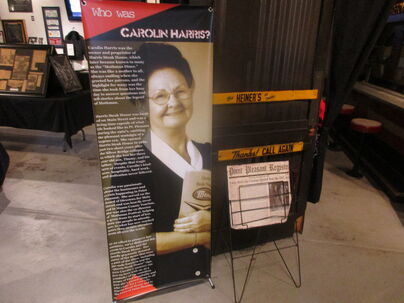
In 2017, an exhibit was added to the Mothman Museum in dedication to Carolin Harris who owned a local diner colloquially referred to as The Mothman Diner. The exhibit features the soda fountain counter and chairs from her restaurant which were donated by her family.
The backroom which houses these items also has a Mothman themed quilt sown by Constance Snyder on the wall as well as chairs and a television for viewing the 2002 "Search For The Mothman" Documentary which plays on repeat.
The long poster reads as following:
Who was Carolin Harris? Carolin Harris was the owner and proprietor of Harris Steak House, which later became known to many as the "Mothman Diner." She was like a mother to all, always smiling when she greeted her patrons, and the highlight for many was the time she took from her busy day to answer questions and tell stories about the legend of Mothman. Harris Steak House and located on Main Street and was a living time capsule of what life looked like in Pt. Pleasant during the 1960's, emitting the pleasant nostalgia of a bygone era. She opened Harris Steak House in 1969, just two short year after the Silver Bridge collapse, in which she lost her three year old son, Timmy, and his father. Despite that tragic turn of events, Carolin's kindness, hospitality, hard work, and dedication never faltered. Carolin was passionate about the businesses and events happening in Point Pleasant. She served on the Board of Directors for Main Street and was heavily involved in Mason County Tourism. She was also the co-director of Mothman Festival, helping it grow from its start of less than 100 people in attendance, to what has now reached more than 10,000 attendees from all over the world. In an effort to preserve her memory, we've dedicated this room to Carolin and the Harris Steak House. Her family graciously donated many of the items that were a part of the diner, including the soda fountain and the "Harris Steak House" sign. Now Carolin's memory can live on here with us, as a reminder of the countless hours of kind hospitality and love she's passed along to all who came for a visit into Harris Steak House and to the town of Point Pleasant.
Novelties, Toys and Miscellaneous
Throughout the museum are posters and paintings of Mothman art. At the end of one of tables there is a glass case filled with toys, novelties and miscellaneous things.
There's also a large glass display case at the end of the movie exhibit which features some interesting items such as different book cover printings of The Mothman Prophecies and audio tapes of an interview from November 1966 with a West Virginia man named Woodrow Derenberger whose story became it's own local folklore; the story of Indrid Cold. It's mostly relevant because it's in The Mothman Prophecies as something John Keel was looking into at the time but also because it's a West Virginia legend from 1966.
Beside of this miscellaneous display case is a mannequin dressed in a Point Pleasant police uniform. The name tag reads "M. Halstead" in reference to Deputy Miller Halstead who was the local deputy at the time of the Mothman reports along with Sheriff George Johnson.
Lastly, there's another Mothman costume. This one was used during the early Mothman festivals and now it stands as a photo opportunity. Next to it is a long poster which reads as following:
Who or what was the Mothman? Some - believe that Mothman was an alien, a supernatural manifestation or an unknown [animal]. Other eyewitnesses described it as a "large bird." Wildlife biologist Dr. Robert L. Smith told reporters that descriptions from many of the eyewitnesses all fit the sandhill crane. That species of American crane had a seven foot wingspan and red feathers above its eyes. Many eyewitnesses were turned off to this alleged theory due to all of the fear and turmoil they experienced as a result of their encounters with the Mothman. They knew that it was no bird. If anything, they thought that perhaps it wasn't even from this world. "The Mothman Prophecies" author, John Keel, became the major chronicler of the Mothman case and wrote that at least 100 people personally witnesses the creature between November 1966 and [Dec]ember 1967. According to the eyewitnesses reports, the creature stood around seven feet tall, was wider than a man and shuffled around on human-like legs. It's eyes were set near the top of the shoulders and had bat-like wings that glided when it flew. It's skin was described as being murky in color with a gray or brownish hue. The theory that Mothman was a omen or a warning sign to alert when a disaster was about to strike, took its roots when sightings of the creature would be reported just before a disaster took place. Some reports claim that he was seen just before the collapse of the Silver Bridge. Whether it was trying to warn of the impending collapse. Mothman [sightings ceased for a long time] in Point Pleasant after the horrific event in December of 1967.
The Old Location:
The Mothman Museum had a previous location at The Lowe Hotel before moving across the street to be directly by The Mothman Statue.
The old location later became The Navy Poster Museum.

